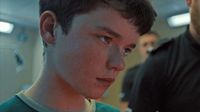Netflix's ambitious new four-part British crime drama, Adolescence, has captivated audiences with its striking real-time cinematography and poignant storytelling, diving deep into themes of youth violence and toxic masculinity. The series revolves around a 13-year-old boy, Jamie Miller, portrayed brilliantly by Owen Cooper. Initially brought into the spotlight as a murder suspect in the stabbing of a female classmate, Jamie's journey through the legal system unfolds in an unflinching manner, inviting viewers to reflect on the complexities behind such acts of violence.
Every episode of Adolescence is shot in one continuous take, an audacious choice designed to immerse viewers in the unfolding narrative without the distraction of cuts. The very first episode commences dramatically with a tactical police team executing a warrant at the Miller home. Jamie is awakened and arrested in his pajamas, surrounded by armed officers, setting the stage for a procedural exploration of his digitized self and the environment that shaped him. From the arrest to the police station, everything is laid bare: finger-printing, health checks, and intense interrogations, each moment more intense than the last.
The show’s creators succeed in their mission to create a piece that not only presents a compelling story but also makes a larger statement about the influences shaping today’s youth. As the narrative progresses over four hour-long episodes, it becomes clear that Jamie reflects the confusion and pressures faced by many young people today, exacerbated by elements like the so-called 'manosphere'. This online community of men discussing masculinity has been linked to rising misogyny and violence, and the show does not shy away from addressing these issues.
This narrative thread has resonated on social media, with fans dissecting Jamie's character. While some describe him as a 'troubled teenager,' others argue that his intelligence and a relatively normal upbringing suggest he may have been radicalized online instead. The ongoing discussion around the series touches on essential cultural conversations about parenting, societal pressures, and the blurred lines between right and wrong in today's digital age.
Industry experts have noted the relevance of the show's themes to real-world situations, particularly in Australia, where a study commissioned by Tomorrow Woman found alarming statistics about young women's safety. One in four female high school students reported feeling unsafe around male peers, and 10% even admitted to carrying weapons for self-defense. Paige Campbell, CEO of Tomorrow Man, points out the confusion many young men experience about masculinity in the wake of shifting societal norms.
Campbell states, “We are seeing the impacts of the manosphere here in Australia. Many young men are confused about what it means to be a man in 2025 and so they go looking for guidance on the internet, which is a space filled with mixed messages.” These societal influences are captured in Adolescence, demonstrating the urgent need for conversations surrounding masculinity that are empowering rather than toxic.
The psychological implications of Jamie's background and actions resonate deeply, forcing viewers to consider how the pressures of the modern world can distort perceptions of identity and relationships. This resonates particularly strongly given the reality of many real-life cases of youth violence, where online radicalization has played a significant role.
As the show progresses, the involvement of Jamie's parents, particularly his father Eddie (played by the talented Stephen Graham), adds layers to the narrative, showcasing the desperate struggle parents face when attempting to navigate their children's tumultuous world. It is through Jamie's interactions with those tasked with understanding him—his arresting detectives and psychologist—that viewers come to witness the heartbreaking intersections of trauma and misunderstandings.
In the final episodes, viewers are offered insight into how Jamie's belief system has been shaped through his online interactions, often displaying reactions driven by misogynistic rhetoric. The representation of such beliefs as potent and dangerous provides a stark reminder that the struggles depicted in Adolescence are not merely fictional but resonate with issues facing real communities.
The raw realism of Adolescence cannot be overstated. Audiences are left with the same questions lingering in their minds long after the credits roll: How do we as a society address the complex issues of youth violence and misogyny? How do we ensure that the young are guided towards healthy views of themselves and others without falling prey to toxic teachings?
With a staggering 24.3 million views in just four days since its release, Adolescence has become a cultural touchstone, forcing both viewers and critics alike to confront uncomfortable truths about the world we live in. What starts as a crime drama morphs into a narrative much broader and far-reaching, making it not only a show worth watching but one that challenges the viewers to engage in crucial conversations about youth, identity, and responsibility.
In conclusion, Adolescence stands out not just as a compelling story but as a powerful cultural commentary on the state of modern masculinity and the profound impact of technology on youth. Its bold filmmaking techniques paired with thought-provoking content make it a landmark series in contemporary television.









